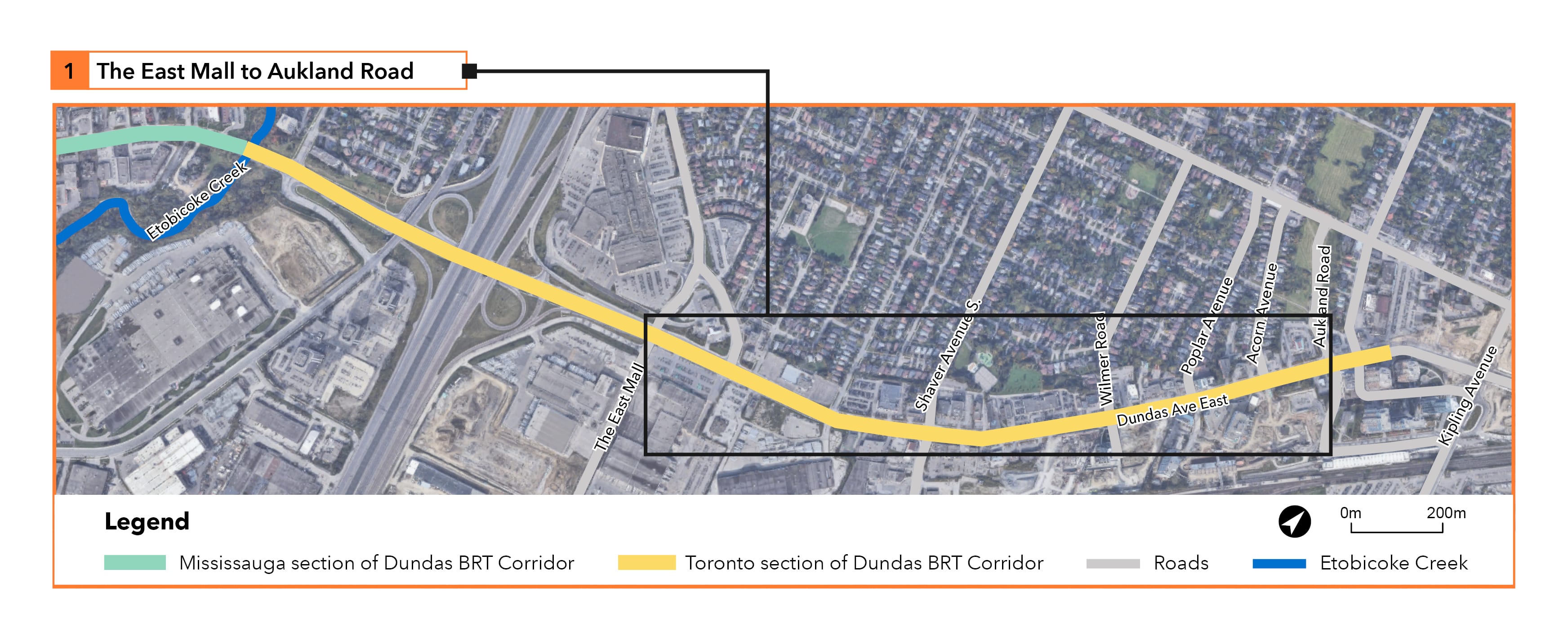
Dundas BRT
- Projects & Programs
- Dundas BRT
- What We're Building
- Toronto Preliminary Design
Toronto – Kipling Transit Hub to Etobicoke Creek

Next steps
Prepare the preliminary design for Toronto based on feedback received during this round of engagement and prepare the Environmental Project Report (EPR) based on the finalized preliminary design.
How is the community involved?
Metrolinx believes that when you have your say our transportation system gets stronger. We are committed to keeping you informed, building understanding and collecting your feedback. Engagement presents an opportunity for you to provide your input.
Preliminary design – pinch points
What is a pinch point?
- Areas of special interest where necessary road widening is constrained by the existing environment.
- Where other design challenges are present (e.g., integrating BRT service into and gaining access to an existing transit station).
The East Mall to Aukland Road Pinch Point
This area is constrained due to the narrow right-of-way (ROW) and numerous approved development applications in the area. The project team will consider:
- Integration of approved urban space.
- Consideration for TTC and MiWay service.
- Consideration, impacts and integration to existing approved development applications.
Three alternatives were reviewed for potential benefits and drawbacks.
- Alternative 1: full median BRT with pinched boulevards, i.e., multi-use path and sidewalk.
- Alternative 2: full median BRT with standard boulevards, i.e., sidewalks, boulevards and cycle tracks.
- Alternative 3: curbside Reserved Bus Lanes (RBL) with standard boulevards.
Alternatives considered
Alternative 1: median BRT with pinched boulevards, i.e., multi-use path and sidewalk.
Benefits
- Full median BRT will improve BRT travel times, efficiency and reliability.
- Continuity of median BRT lanes from Mississauga East.
- Maintains general 36m right of way and boulevard as identified in the Official Plan.
- Provides sidewalks and dedicated physically protected cycling facilities.
Drawbacks
- Higher capital cost.
- Reduced potential for property impacts.
- Increased auto travel times for peak period conditions.
- Minimum 3.3m curb lane presents challenges for MiWay operating in mixed traffic.
Alternative 2: median BRT with standard boulevards, i.e. sidewalks, boulevards and cycle tracks
Benefits
- Full median BRT will improve BRT travel times, efficiency and reliability.
- Continuity of median BRT lanes from Mississauga East.
- Maintains general 36m right of way and boulevard as identified in the Official Plan.
- Provides sidewalks and dedicated physically protected cycling facilities.
Drawbacks
- Greatest capital cost.
- Greatest potential for property impacts.
- Increased auto travel times for peak period conditions.
- Minimum 3.3m curb lane presents challenges for MiWay operating in mixed traffic.
Alternative 3: curbside reserved bus lanes with standard boulevards
Benefits
- Lowest capital cost.
- Maintains general 36m right of way identified in the Official Plan.
- Full amenity boulevard as per Official Plan and Public Realm requirements.
- Provides sidewalks and dedicated physically protected cycling facilities.
Drawbacks
- Dedicated physically separated BRT facilities not provided, reducing transit priority.
- No continuity of median BRT lanes from Mississauga East.
- Potential conflicts between bus passengers with cyclists in cycle tracks at curbside bus stops.
Evaluation of Alternatives
Evaluation of alternatives: Kipling Transit Hub to Etobicoke Creek
Alternative 2 is the best performing alternative due to:
- Transit travel time savings.
- Transit reliability.
- Managing the associated capital, property and operating and maintenance costs.
- Traffic operations, intersection level of service and auto travel times.
- Alignment with the City’s Official Plan.
What is the distance between each stop?
Stop locations are based on:
- Access versus travel time
- Current transit facilities and intersecting bus routes that form the basis of a feeder network.
- Distance between stops.
- Land use and major trip generators.
Work has advanced on establishing the proposed stop locations. Three stop locations within Toronto have been identified.
What is a stop?
A stop is a designated area where the Dundas BRT will stop to pick up and drop off passengers. The scale and amenities of each stop will reflect the ridership or existing infrastructure in the area.
Not shown: Fare collection, arts and cultural heritage elements